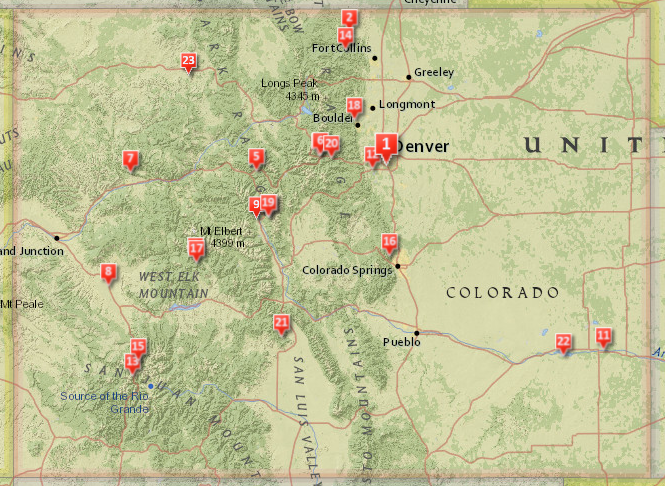Nonpoint Source Project Resources
Project Development Resources
-
Colorado’s Integrated Water Quality Monitoring and Assessment Report.
-
GIS Maps, including stream segmentation, watershed plans, outstanding waters, and eRAMS.
-
Key to the Water Body Identification (WBID) System.
Determining Pollutant Sources and Load Reductions
Identification of causes or threats of impairment and pollutant source reductions needed to meet water quality goals requires accounting for various NPS pollutants. Watershed characterization and analysis provides information on point and nonpoint sources of pollutants. Strategic monitoring provides a better understanding of the water quality concerns and evaluates best management practice (BMP) effectiveness in order to meet water quality goals after implementation. In addition to monitoring, watershed modeling can be used to estimate pollutant load reductions. Models represent an environmental system and can be used to forecast or estimate future conditions under various situations. Monitoring may need to be done in addition to modeling to refine results at a smaller, local scale.
Monitoring Resources
The following resources can be helpful to design watershed characterization studies to assess water quality as well as evaluate BMP effectiveness post-implementation:
- Colorado Watershed Assembly’s Water Quality Monitoring 101
- Colorado Water Quality Monitoring Council (CWQMC)
- EPA’s Introduction to Water Quality Monitoring
- National Nonpoint Source Monitoring Program (NNPSMP)
- National Water Quality Monitoring Council
- River Watch of Colorado
Modeling Resources
CDPHE’s NPS Program funded development of the following modeling and analysis tools on Colorado State University’s (CSU) eRAMS platform:
- Abandoned Mines Lands (AML) Dashboard
- Agricultural Chemicals and Groundwater Protection Program (ACGP)
- Nonpoint Source Priority Dashboard (NPSPD)
- Nutrient Decision Support System (NDSS)
- Watershed Rapid Assessment Program (WRAP)
Additional modeling options are available on EPA’s surface water quality modeling tools and geomorphology assessments for watershed health webpages. Examples of other models and assessments include:
- Forest Service Water Erosion Prediction Project (WEPP)
- Spreadsheet Tool for Estimating Pollutant Load (STEPL)
- Storm Water Management Model (SWMM)
- Watershed Assessment of River Stability and Sediment Supply (WARSSS)
Contracting Process
Instructions by contractor type:
Includes counties, cities and towns, school districts, fire districts, other special districts and political subdivisions.
These are the required documents to enter into a contractual agreement with the state:
These are the required documents to enter into a contractual agreement with the state:
These are the required documents to enter into a contractual agreement with the state:
Example contract
Project Administration and Reporting
-
EPA’s Water Quality Exchange (WQX) and the Water Quality Portal (WQP).
- Invoice Templates:
- Semi-Annual Report Template.
Regulation 85
Colorado’s NPS Program works with partners to implement voluntary NPS provisions of Reg. 85. The Division’s Nutrient Management Plan and 10-Year Water Quality Roadmap identifies voluntary actions for NPS provisions of Regulation 85:
-
Collaborate with the agricultural community to implement BMPs;
-
Work with partners to implement public information and education programs focused on NPS pollution prevention and restoration activities;
- Collaborate on the development and implementation of NPS monitoring programs; and
-
Evaluating nonpoint source to point source nutrient trading proposals.
More information on Regulation 85 is available on the division’s clean water nutrients page, and on CSU’s outreach page on Reg. 85.
NPS Success Stories
The NPS Program submits a Success Story to EPA annually to highlight where NPS best management practices in an impaired waterbody led to that waterbody meeting water quality standards. These restoration and protection projects are collaborative efforts, and reflect the continued effort across many entities to improve water quality in the state.
Explore these projects on EPA’s Success Story page.
There are many ways to evaluate all aspects of project success. A high priority for nonpoint source implementation projects is to measure success as it relates to water quality improvement.
Sampling protocols
-
Stream discharge
- Water quality
Sampling and Analysis Project Plan (SAP)
Water Quality Control Division’s rivers, lakes and streams page
Information about assessment, 303(d) listing, nutrients, temperature and data.
The Water Quality Control Division’s Water Quality Engagement Webpage provides updates on regulations, guidance, and policies as well as engagement opportunities for the public.
If you would like to be added to or removed from the NPS Program’s email list, please contact: cdphe_wqcd_nonpointsource+managers@state.co.us
Kenan Diker
Agricultural Water Quality Specialist
kenan.diker@state.co.us
303-692-3597
Kendra Kelly
Project Coordinator
kendra.kelly@state.co.us
303-692-2886
Kate MacDonald
Project Coordinator
kate.macdonald@state.co.us
303-692-2887
Tammy Allen
Restoration & Protection Unit Manager
tamara.allen@state.co.us
303-692-3554
Jamie Duvall
Nonpoint Source Program Coordinator
Email: jamie.duvall@state.co.us
720-504-9123
